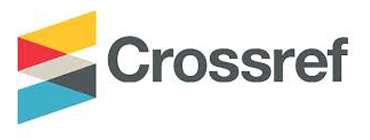ANALISIS KARAKTERISTIK SOAL KEMAMPUAN KONEKSI MATEMATIKA PENSKORAN POLITIMUS
Abstract
Full Text:
PDFReferences
Allen, M. J., & Yen, W. M. (2001). Introduction to measurement theory. California: Waveland Press, Inc.
Azwar, S. (2016). Dasar-dasar psikometri. Yogyakarta: Pustaka Pelajar.
Baiduri, Putri, O. R. U., & Alfani, I. (2020). Mathematical connection process of students with high mathematics ability in solving PISA problems. European Journal of Educational Research, 9(4), 1527–1537. https://doi.org/10.12973/EU-JER.9.4.1527
DeMars, C. (2010). Item response theory. Oxford University Press.
Desjardins, C. D., & Bulut, O. (2018). Handbook of educational measurement and psychometrics using R. CRC Press.
García-García, J., & Dolores-Flores, C. (2018). Intra-mathematical connections made by high school students in performing Calculus tasks. International Journal of Mathematical Education in Science and Technology, 49(2), 227–252. https://doi.org/10.1080/0020739X.2017.1355994
Hair, J. F., Black, W. C., Babin, B. J., Anderson, R. E., & Tatham, R. L. (2009). Análise multivariada de dados. Bookman editora.
Hambleton, R. K., Shavelson, R. J., Webb, N. M., Swaminathan, H., & Rogers, H. J. (1991). Fundamentals of item response theory. Sage.
Hermawan, D., & Prabawanto, S. (2015). Pengaruh Penerapan Model Pembelajaran Problem Based Learning Berbantuan Media Teknologi Informasi dan Komunikasi Terhadap Kemampuan Koneksi Matematis Siswa Sekolah Dasar. EduHumaniora | Jurnal Pendidikan Dasar Kampus Cibiru, 7(1), 1–9. https://doi.org/10.17509/eh.v7i1.2791
Istiyono, E. (2018). Pengembangan Instrumen Penilaian dan Analisis Hasil Belajar Fisika dengan Teori Tes Klasik dan Modern. UNY Press Yogyakarta.
Jailani, Retnawati, H., Apino, E., & Santoso, A. (2020). High school students’ difficulties in making mathematical connections when solving problems. International Journal of Learning, Teaching and Educational Research, 19(8), 255–277. https://doi.org/10.26803/ijlter.19.8.14
Kenedi, A. K., Helsa, Y., Ariani, Y., Zainil, M., & Hendri, S. (2019). Mathematical Connection of Elementary School Students to Solve Mathematical Problems. Journal on Mathematics Education, 10(1), 69–80. https://doi.org/10.22342/jme.10.1.5416.69-80
Manalu, A. C. S., Septiahani, A., Permaganti, B., Melisari, M., Jumiati, Y., & Hidayat, W. (2020). Analisis kemampuan koneksi matematis siswa SMK Pada materi fungsi kelas XI. Jurnal Cendekia : Jurnal Pendidikan Matematika, 4(1), 254–260. https://doi.org/10.31004/cendekia.v4i1.198
Mardapi, D. (2016). Pengukuran penilaian dan evaluasi pendidikan. Yogyakarta: Nuha Medika, 45.
National Council of Teachers of Mathematics. (2000). Standards for teaching and learning mathematics. Reston, VA: Reston, VA : NCTM. Diambil dari https://www.nctm.org/Handlers/AttachmentHandler.ashx?attachmentID=YrwYUOB4xnA=
Nugraha, A. A. (2018). Analisis Kemampuan Koneksi Matematis Siswa SMP pada Materi Sistem Persamaan Linear Dua Variabel (SPLDV). Suska Journal of Mathematics Education, 4(1), 59–64. https://doi.org/10.24014/sjme.v3i2.3897
Ramesh, M., Sathiyaseelan, S., & Ajit, I. (2019). The portrayal of great mathematicians in movies: A review. International Journal of Recent Technology and Engineering, 7(5C), 182–185. Diambil dari https://www.ijrte.org/download/volume-7-issue-5c/
Retnawati, H. (2014). Teori respons butir dan penerapannya: Untuk peneliti, praktisi pengukuran dan pengujian, mahasiswa pascasarjana. Yogyakarta: Nuha Medika.
Retnawati, H. (2016). Validitas reliabilitas dan karakteristik butir. Yogyakarta: Parama Publishing.
Rodríguez-Nieto, C. A., Rodríguez-Vásquez, F. M., & Moll, V. F. (2020). A new view about connections: the mathematical connections established by a teacher when teaching the derivative. International Journal of Mathematical Education in Science and Technology. https://doi.org/10.1080/0020739X.2020.1799254
Saepuzaman, D., Istiyono, E., Haryanto, H., Retnawati, H., & Yustiandi, Y. (2021). Analisis karakteristik butir soal fisika dengan pendekatan IRT penskoran dikotomus dan politomus. Radiasi: Jurnal Berkala Pendidikan Fisika, 14(2), 62–75. https://doi.org/https://doi.org/10.37729/radiasi.v14i2.1200
Saminanto, & Kartono. (2015). Analysis of mathematical connection ability in linear equation with one variable based on connectivity theory. International Journal of Education and Research, 3(4), 259–270. Diambil dari https://www.ijern.com/April-2015.php
Sudaryono. (2011). Implementasi teori responsi butir (Item Response Theory) pada penilaian hasil belajar akhir di sekolah. Jurnal Pendidikan dan Kebudayaan, 17(6), 719. https://doi.org/10.24832/jpnk.v17i6.62
Swastika, G. T., & Narendra, R. (2019). ARIAS learning model based on a contextual approach to increase the mathematical connection capacity. JIPM (Jurnal Ilmiah Pendidikan Matematika), 7(2), 104. https://doi.org/10.25273/jipm.v7i2.2984
Yaniawati, R. P., Indrawan, R., & Setiawan, G. (2019). Core model on improving mathematical communication and connection, analysis of students’ mathematical disposition. International Journal of Instruction, 12(4), 639–654. https://doi.org/10.29333/iji.2019.12441a
Yildiz, H. (2021). IRTGUI: An R Package for Unidimensional Item Response Theory Analysis With a Graphical User Interface. Applied Psychological Measurement, 45(7–8), 551–552. https://doi.org/10.1177/01466216211040532
Zanon, C., Hutz, C. S., Yoo, H., & Hambleton, R. K. (2016). An application of item response theory to psychological test development. Psicologia: Reflexão e Crítica, 29(1), 18. https://doi.org/10.1186/s41155-016-0040-x
Zengin, Y. (2019). Development of mathematical connection skills in a dynamic learning environment. Education and Information Technologies, 24(3), 2175–2194. https://doi.org/10.1007/s10639-019-09870-x
DOI: http://dx.doi.org/10.30829/tar.v29i2.1650
Refbacks
- There are currently no refbacks.

Jurnal Tarbiyah by UIN Sumatera Utara Medan is licensed under a Creative Commons Attribution-NonCommercial-ShareAlike 4.0 International License.
Based on a work at http://jurnaltarbiyah.uinsu.ac.id/index.php/tarbiyah.
Permissions beyond the scope of this license may be available at http://jurnaltarbiyah.uinsu.ac.id/index.php/tarbiyah/about/submissions#copyrightNotice.
















